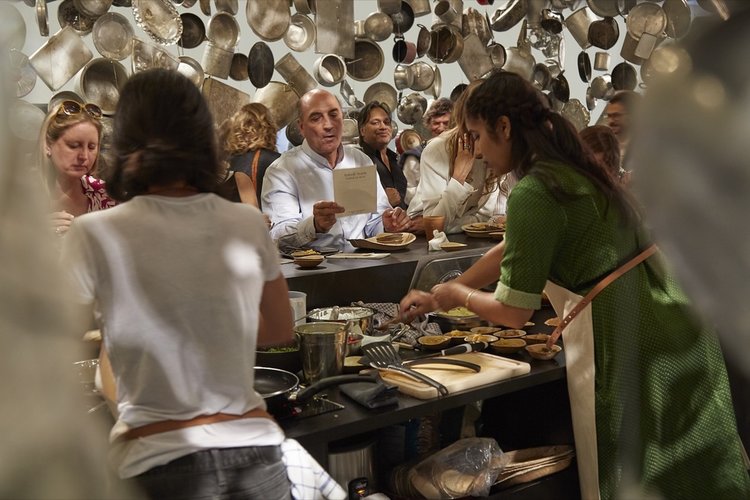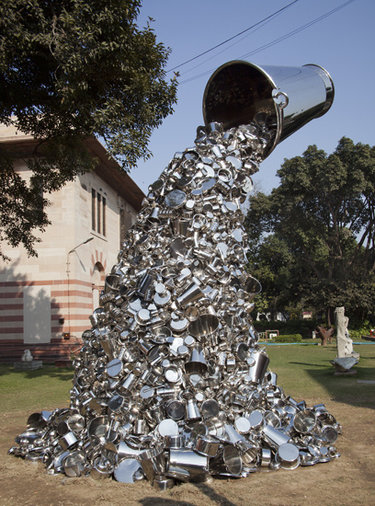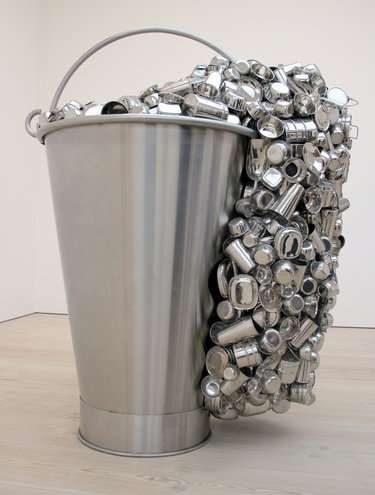Riposte | Cooking the World Subodh Gupta at Art Basel
Each fortnight, HeadStuff brings an unadulterated critique of the global art scene. Click here for more.
Cooking the World (2017) by Subodh Gupta at the Art Basel fair recreates ritualistic practices of community eating. The installation space is made of utensils from the scrapyard marketplace, adding a feel of the familiar home environment, rather than the cold anonymity that modern lifestyles have added to our eating habits. “Everything goes back to my childhood. I grew up in a house with so many utensils like these, so it’s like home to me,” states Gupta.
The accompanying performance to the installation, will feature an apron-clad Gupta serving traditional Indian cuisine to the viewers – Gupta’s menu at Art Basel embraces dishes like cheela, Goan prawn curry, lamb curry, and lentil soup. And in an age of migration and displacement, complemented by a rising intolerance for different cultural practices Gupta’s work on the rituals and symbolism of food consumption and preparation has gathered increasing significance. “While I cook, I am also consciously exploring the socio-political aspects of cooking and eating. In India, cooking and eating embraces all classes – it is reflected by inclusivity and exclusivity, belonging and not-belonging. Communities are known by what they eat or don’t eat,” says Subodh.
Cooking the World thus aims to show that in all cultures, the notion of gathering around the dinner table indicates a sense of familial bond and intimacy in the practice of sharing a meal. The meals are free to Art Basel ticket holders. However, it is worth remembering that a ticket for Basel costs upwards of €50.

Depending on where you are in the world, food is a source of sustenance or pleasure. Consuming calories is essential to our survival, but our location on the globe is often indicative of our relationship with food. Geography isn’t the only factor when it comes to food. Food is intrinsically entwined in the socio-politics of any land. Wars are ignited in the name of food, famine used a WMD.
What we consume is often testament to our background. Growing up in the Irish Midlands, I generally had a lot of beef, pork, vegetables and dairy in my diet as a child. As I’ve gotten older my palate has changed with more emphasis put on vegetables, spices and herbs. Those two sentences say a lot about my upbringing – Irish, white and middle class. I’ve had the luxury and privilege of choosing what I eat, varying my protein and adding elements of other cultural cuisines to it.

Food and community are indispensable elements of Irish society which have become slightly detached. But we are seeing a trend throughout the country actively encouraging people to bring the two back together. Think of funerals, and the all merciful amount of ham sandwiches the grieving family will receive. Speaking of ham sandwiches, pop along to any GAA match outside of the bigger towns and cities and you’ll find a congregation of people around the boot of car, munching on a buttered batch loaf, with chunks of boiled ham inside, sipping on a flask of tea – the best kind of tea. Perhaps the days of the skillet pot on the fire to feed the whole village have gone, but all is not lost when it comes to food and community in Ireland.
Indian contemporary artist, Sudoh Gupta, sees how Western cultures are panicked at the concept of losing community. Throughout London, Dublin, New York and various other Western cities, people are scrambling together to organise supper clubs which bring people together in large groups to break bread. For Gupta, born in Bihar, the concept of gathering around a large table to eat resonates powerfully, and is commonplace throughout ancient and modern India. His Art Basel performance/installation gathers people at a long table where Indian foods are cooked and presented to the viewer to consume, recycled aluminium pots and pans suspended on fishing line above their heads. Steel, aluminium, tin and other such materials have been prevalent throughout Gupta’s career, paying homage to his Indian upbringing and to the work of French conceptualist Marcel Duchamp.
Apart from the food elements of the installation, the fishing lines and pots are incredibly interesting, and perhaps a rather cutting response to Western society. In many ways, it appears Gupta is laughing at Westerners fervently trying to create community having spent years rejecting and destroying the concept. Interpreting the materials used, I think it’s relatively fair to assume that it’s pointing towards how wasteful Westerners are, and how dependent we’ve become on convenience. Can we fish? No, but we sure can buy several pans in which to cook the store-bought fish from, then throw them away when we realise it’s easier to put JustEat on our phones and have someone else cook for us instead.

What the artist has a created is a mirror into which Western cultures should look. While the idea of creating and hosting events to encourage community is great, we’re only putting a bandage over a symptom instead of looking at the problem. Though Gupta insists that the installation is to promote inclusion through food, everything about the art piece seems too obvious, which is something I love about it. I love that on the surface he has created a sense of familiarity and comfort, but you don’t need to scratch too far to see there’s more to it than that.
I find it telling that he wants to convince viewers that inclusion is the modus operandi, the same tagline that supper/baking/dinner clubs around the world use. The artist has presented to us Western society’s simultaneous obsession with creating the sense of community, while rejecting certain members of society at the same time. The installation manages to open a conversation on minority, migrant and class issues, all under the guise of creating a sense of community. Throughout his career, Gupta has referenced the grim realities of migration and commented on the shifting economic and cultural atmosphere in India. His work has often brought into question the consequences in store for India as it’s faced with wanting to hold onto tradition in the face of globalisation.
Gupta’s installation melds consumption and society into one. It certainly made me think about Ireland and how the food-scape has changed in my living memory. Dublin is one big food fad after another, and has been that way for years, but when we take the city blinkers off what we’re looking for is there. Orange slices at half time, a Tayto sandwich with your friends after a long week in work, the punnet of Wexford strawberries from the Junior Cert employee on the side of the road, or the 99 you eat in May with your gloves still on. It’s not haute cuisine, they won’t make a Netflix documentary about it, but it’s part of our communities and part of our narrative.
It’s far from donuts we were reared.
